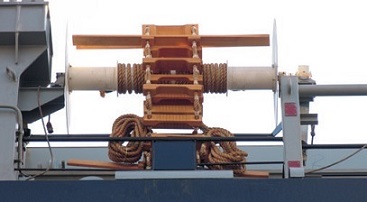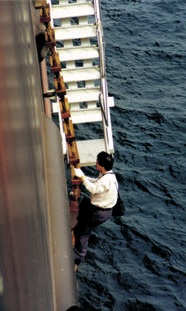Pilot is a person who is qualified to assist ship master in navigation while entering or leaving
a port. For the safe embarkation and disembarkation of the pilot
master shall designate a Deck Officer for verifying the safe condition, safe access and appropriate rigging of the pilot ladder / combination ladder (accommodation ladder) per local requirement and ensure that a heaving line and lighted life buoy is available at the point of embarkation or disembarkation.
The pilot ladder is a rope ladder provided for a pilot to embark and disembark safely. The pilot
ladders shall be located in a place clear from any possible ship discharges. According to
SOLAS, the length shall be sufficient to reach the water surface when the vessel in ballast
condition has an adverse list of 15°. Unfortunately, such a ladder is too long with steps on the deck of the pilot boat presenting a hazard to both the Pilot and deckhand. In practice
it would be better to have two additional ladders with length adjusted to prevailing
draught conditions.
 Note: Pilot ladders on stowage drum tend to stay clean,
Note: Pilot ladders on stowage drum tend to stay clean,
are easy to rig, retrieve and survey,
and they last
longer too.However, the drum should NOT be used to
hoist/lower a pilot
from/to the pilot boat.
In case of high freeboard (more than 9m), the pilot ladder shall be combined with an accommodation ladder.
He shall stay in contact with the bridge and escort the Pilot to and from the bridge.
The Master shall further assure the safety of the Pilot during embarking or disembarking by providing a good lee to the pilot boat.
Refer to Required Pilot Boarding Arrangements, prepared as per requirements of IMO and IMPA (International Maritime Pilots’ Association)
Pre -arrival planning:
Passage plan shall also cover pilotage waters. The plan shall identify charted features that will assist monitoring progress & include contingency measures in the event of equipment failure, poor visibility etc. Pilot Card shall be prepared in advance.

Fig: pilot boarding
It is unlikely that every detail of passage will have been predicted in pilotage waters. Much of what will have been planned may have to be changed after embarking the Pilot. This in no way lowers the real value of the plan, which is to mark out in advance where the ship must not go and the precautions which must be taken to achieve that end, or to give initial warning that the ship may be running into danger.
The plan must be flexible and may be amended by the Master at any time in the interest of safety.
Master/pilot information exchange:
The pilot shall be informed the ship’s heading, speed & engine setting and handed the pilot card.
The master and the pilot should exchange information regarding navigational procedures, local conditions and rules and the ship’s characteristics. This information exchange should be a continuous process that generally continues for the duration of the pilotage.
This exchange of information should include at least: -
Presentation of a completed ‘Pilot Card & Information Exchange’ ;
-
General agreement on plans and procedures, including contingency plans, for the anticipated passage;
-
Discussion of any special conditions such as weather, a minimum depth of water available, tidal currents and marine traffic that may be expected during the passage;
- Discussion of ship-handling characteristics, machinery difficulties, navigational equipment problems that could affect the operation, handling or safe maneuvering of the ship;
- Information on berthing arrangements; use, characteristics, and number of tugs; mooring boats and other external facilities;
- Information and availability of mooring arrangements
Caution / during Pilot onboard
Final responsibility on the commanding the vessel :
The Pilots, their presence on board does not relieve the Master or officer in charge of a navigational watch from their duties and obligations for the safety of the ship.
The Master and the officer in charge of the navigational watch shall co-operate closely with the Pilot.
• Monitoring for result of navigational actions :
The safe progress of the ship as planned should be monitored closely at all times, including track monitoring and regular fixing of the position of the ship, particularly after each course alteration, as well as monitoring of under keel clearance.
• “Doubled and redoubled safety measures” with Pilot’s order :
Compliance with Pilot’s advice should be verified by checking rudder indicator against helm ordered and similarly the RPM indicator against M/E (telegraph) order.
• While the Master is leaving from wheelhouse :
If the Master leaves the bridge, the officer in charge of the navigational watch should always seek clarification from the Pilot when in any doubt as to Pilot’s actions or intentions, and if doubt still exists, shall notify the Master immediately, taking whatever action is necessary before the Master arrives.
Note:
Where marine casualties have occurred with a pilot on board, many have been caused by faulty master/pilot relationships. In many cases, when the Pilot boarded the ship, the Master and the officer in charge of the navigational watch ceased to monitor the navigation of the ship.
Training on handling of equipment for pilot boarding and leaving
The Chief Officer shall train the crew members in charge of the equipment for the pilots boarding and leaving, by having them well understand the “Pilot Transfer Arrangements and their Operations.”
Related articles
Procedures for safe helicopter operations
Ships navigation in restricted visibility check item
Ships navigation in confined water check item
Ships navigational equipment in Pilotage operation
Check items in a navigational watch during pilotage
Collecting Information and Data for Passage Planning

Other info pages !
Ships Charterparties Related terms & guideline
Stevedores injury How to prevent injury onboard
Environmental issues How to prevent marine pollution
Cargo & Ballast Handling Safety Guideline
Reefer cargo handling Troubleshoot and countermeasures
DG cargo handling Procedures & Guidelines
Safety in engine room Standard procedures
Questions from user and feedback Read our knowledgebase
Home page

ShipsBusiness.com is merely an informational site about various aspects of ships operation,maintenance procedure,
prevention of pollution and many safety guideline. The procedures explained here are only indicative,
not exhaustive in nature and one must always be guided by practices of good seamanship.
User feedback is
important to update our database. For any comment or suggestions please Contact us
Site Use and Privacy - Read our privacy policy and site use information.
//Home //Terms and conditions of use
Copyright © 2015 www.shipsbusiness.com All rights reserved.




